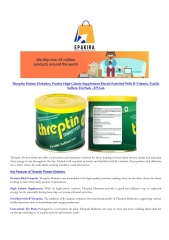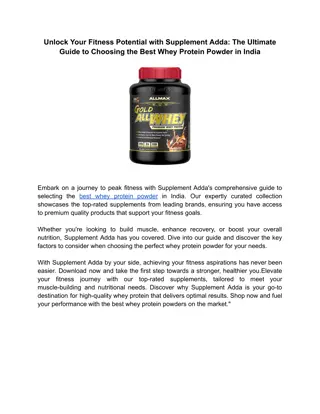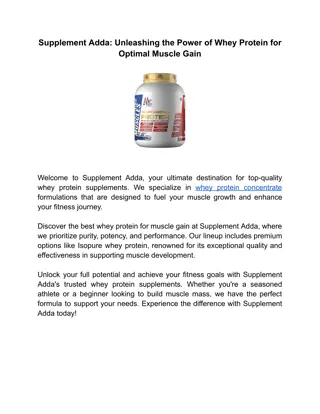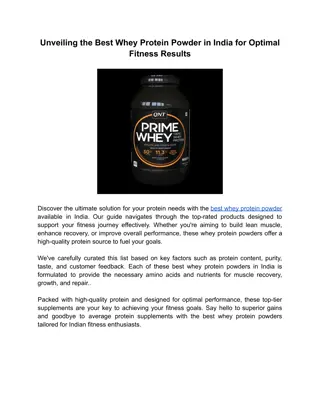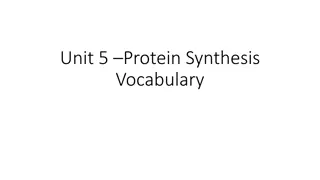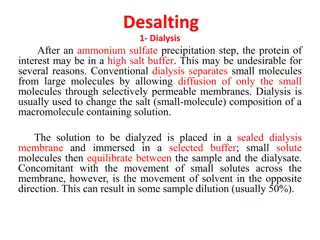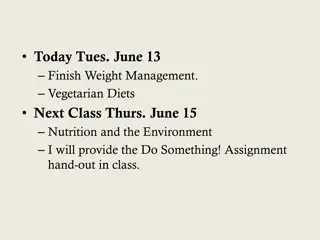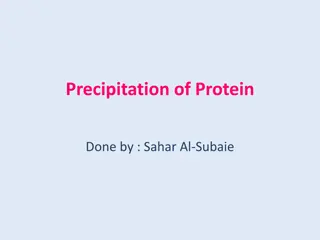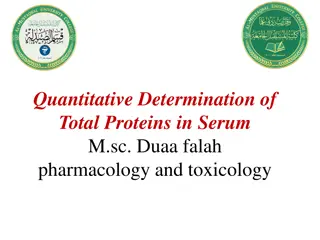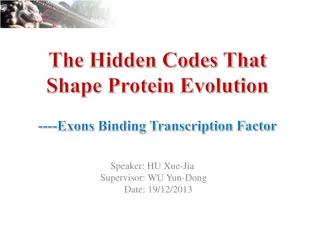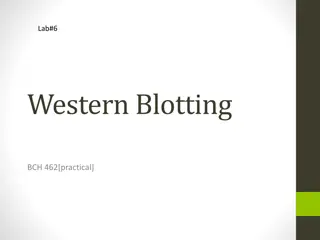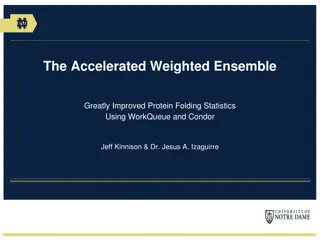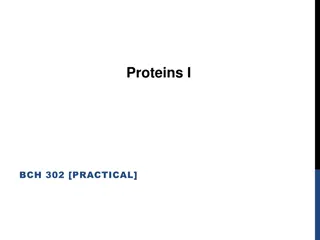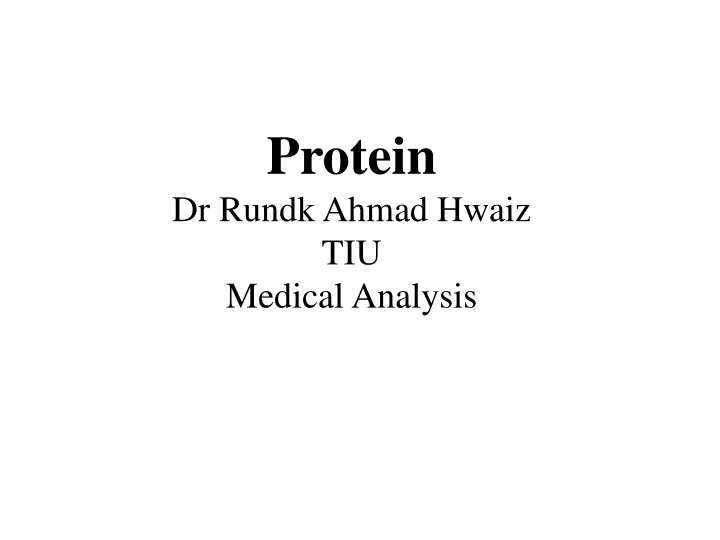
Importance of Proteins in Cell Functions
Proteins play crucial roles in cell functions, including transportation, movement, immune defense, and catalyzing reactions. There are around 100,000 different proteins in cells, each made up of a chain of 20 different L-amino acids. The structure and function of proteins are determined by amino acid side chains. Learn more about the significance of proteins in cellular activities and the diverse functions they serve.
Download Presentation

Please find below an Image/Link to download the presentation.
The content on the website is provided AS IS for your information and personal use only. It may not be sold, licensed, or shared on other websites without obtaining consent from the author. If you encounter any issues during the download, it is possible that the publisher has removed the file from their server.
You are allowed to download the files provided on this website for personal or commercial use, subject to the condition that they are used lawfully. All files are the property of their respective owners.
The content on the website is provided AS IS for your information and personal use only. It may not be sold, licensed, or shared on other websites without obtaining consent from the author.
E N D
Presentation Transcript
Protein Dr Rundk Ahmad Hwaiz TIU Medical Analysis
Everything that happens in a cell is dependent on proteins in one way or another. There are proteins that transport other molecules, such as hemoglobin that transports oxygen from our lungs to various tissues. Some proteins allow us to move, like the proteins that build up muscle tissue, Proteins in our immune system take care of foreign particles and molecules and make sure that they do not cause damage.
Other proteins give us protection against the environment and stability in the form of skins, bones and hair. There is a large group of proteins that catalyze all the reactions that take place in our cells.
It is estimated that there are close to 100,000 different proteins in our cells. Although all proteins have different structure and function, they are structured in the same principle. All proteins consist of a chain of the 20 different -amino acids where each amino acid is joined to the next by a peptide bond (also called amide bond). The amino acid side chains will determine both structure and function of the protein.
The largest protein, called titin and found in our muscles, contains more than 36,000 amino acids. While some other proteins consist of only about ten amino acids.
Amino acids All amino acids present in proteins are called L- amino acids because the amino group is bound to the alpha carbon. The carboxyl group and the side chain as well as a hydrogen atom are also bonded to the alpha carbon. Since four different groups are bound to the alpha carbon, this means that there are two different forms, so-called stereoisomers, and in proteins there are only amino acids of the L-form.
Amino group Carboxyle group Carbon Side chain Uncharged amino acid
Because alpha carbon has 4 diffrent group so the carbon is chiral carbon but the exception from this, is the amino acid Glycine. These 4 groups are: Amino group, COOH, Hydrogen atom, Sidechain (R).
For a free amino acid in water, the carboxyl group has a pKa value of about 2 while the amino group has a pKa between 9 and 11. Therefore, at neutral pH, the carboxyl group will drop a proton and become negatively charged (-COO-) while the amino group takes up a proton and receives a positive charge (-NH3 +).
Amino group Carboxyle group Carbon Side chain Charged (ionized) amino acid
All amino acids are structured in the same way. What distinguishes the 20 amino acids found in proteins is the side chain. For example the side chain in alanine is a methyl group, while glycine, which is the simplest amino acid, has only one hydrogen atom in the side chain.
Amino acid side chains The side chains differ in size, shape, solubility (polarity), charge, and reactivity. Therefore, the amino acids are usually divided into groups depending on the chemical properties of the side chain.
Among the unpolar amino acids, the side chain of glycine is least unpolar, while the long aliphatic side chains of leucine and isoleucine are highly unpolar. The more unpolar an amino acid is, the worse its solubility in water.
The amino acid proline is a little special because it is ring-closed. As a result, the bond between the alpha carbon and the amino group's nitrogen atom cannot rotate freely, which in turn affects which secondary structures proline can participate in.
Both glycine and proline called alpha helix breaker They are both play a role in disrupting a particular pattern found in secondary protien structure called alpha helix. An alpha helix is a coiled up polypeptide chain because of its secondary alpha amino group, proline introduce kinks into this alpha helix and also since glycine is so flexible around this alpha carbon it tends to do the same thing.
Histidine also differs from the other amino acids. Namely, histidine is the only amino acid where the side chain has a pKa value in the vicinity of 7.
Cystien has special thiol group on the side chain. Thiol refering to sulfer and hydrogen at the end. Cystien can make disulfer bond with each other withen a polypeptide chain or even between two different polypeptide chains. So thier side chains can form bond together between the two sulfer atom called disulfide bridge.
At pH 7, the acidic amino acids, aspartate (aspartic acid) and glutamate (glutamic acid) will have a negatively charged side chain, while the side chains of arginine and lysine will be positively charged.
The aromatic amino acids phenyalanine, tyrosine and tryptophan have spectral properties that allow them to absorb light in the UV range. This property can be used to determine the concentration of a protein solution.
Side chain properties Amino acids are often classified according to their side chain properties. This table shows the properties of the side chain of a free amino acid.
Properties of the Amino Acids The characteristics of the amino acids depend on the composition of their R side chain. Using the single-letter abbreviations: Polar or Hydrophilic: N, Q, S, T, K, R, H, D, E Non-Polar or Hydrophobic: A, V, L, I, P, Y, F, M, C Contain Sulfur: C, M Hydrogen Bonding: C, W, N, Q, S, T, Y, K, R, H, D, E Ionizable: D, E, H, C, Y, K, R Cyclic: P Aromatic: F, W, Y (H also, but doesn't display much UV absorption) Aliphatic: G, A, V, L, I, P Forms a Disulfide Bond: C Acidic (Positively Charged at Neutral pH): D, E Basic (Negatively Charged at Neutral pH): K, R
Proteins and peptides are polymers made up of amino acid units (residues) that are linked together through the formation of amide bonds (peptide bonds) from the amino group of one residue and the carboxylate of a second residue.
A peptide or polypeptide has two different ends. The amino terminal (N-terminal) is the amino group while the carboxyl terminal (C-terminal) is the carboxyl group. The order of amino acids from N-terminal to C-terminal is the primary structure of the protein.
In a peptide, the amino acids are written from left to right with the (NH3+) group on the left and (COO-) group on the right. The left hand amino acid is called the N-terminus and the right hand amino acid is called the C-terminus.
peptide: the name given to a short polymer of amino acids joined by peptide bonds; they are classified by the number of amino acids in the chain. dipeptide: a molecule containing two amino acids joined by a peptide bond. tripeptide: a molecule containing three amino acids joined by peptide bonds.
polypeptide: a macromolecule containing many amino acids joined by peptide bonds. protein: a biological macromolecule, consisting of one or more polypeptide chains.
Write three-letter abreviations and names of tripeptides that could form from two glycine and one alanine.
Glycine glycine alanin Gly-Gly-Ala Glycine alanine glycine Gly-Ala-Gly Alanine glycine glycine Ala-Gly-Gly
What is the possible tripeptides formed from one each of leucine, glycine and alanine?
Luc-Gly-Ala Leu-Ala-Gly Ala-Gly-Leu Ala-Leu-Gly Gly-Ala-Leu Gly-Leu-Ala
Protein Structures 1. Primary structure 2. Secondary structure 3. Tertiary structure 4. Quarternary structure
Primary structure 1. Protein primary structure is the linear sequence of amino acids in a peptide or protein. 2. The amino acids in the primary structure are held together by covalent bonds, which are made during the process of protein synthesis.
A peptide or polypeptide has two ends. The amino terminal (N-terminal) is the amino group (on the first amino acid in the chain) while the carboxyl terminal (C-terminal) is the carboxyl group on the last amino acid in the peptide. The order of amino acids from N-terminal to C-terminal is the primary structure of the peptide or protein.
Secondary structure 1. -helix is a right-twisted helical structure 2. The structure allows hydrogen bonds between the amide proton and the carbonyl acid in the peptide bond to be formed. 3. The hydrogen bond is formed between the amide proton of an amino acid and the carbonyl acid of the other amino acid.
-sheet 1. A -strand is an extended structure. 2. Two or more -strands may be adjacent to each other, thereby forming a -sheet which is held together with hydrogen bonds between the amide proton in one - strand and the carbonyl acid in another -strand.
Tertiary structure 1. The final structure that a protein forms depends on which amino acids are included in the primary structure. Through the hydrophobic effect, the protein is folded so that unpolar amino acids are placed inside the protein without contact with the surrounding water. By folding, polar side chains will be placed on the surface, making the protein water- soluble. 2. The structure formed is stabilized by hydrogen bonds, ionic bonds, van der Waals interactions and disulfide bonds between the amino acid side chains.
Quarternary structure Some proteins consist of several parts (subunits) and therefore have an additional structural level. The quaternary structure describes how these individual parts relate to each other in space. An example of a protein with quaternary structure is hemoglobin.
Native Structure 1. The primary structure contains all the information needed to properly fold a protein. 2. If you destroy the structure and denture the protein (with heat, acid or otherwise) while reducing all the disulfides, you get a completely unfolded protein chain. If you then lower the temperature or remove the agent that caused the denaturation, the protein will be folded back to its normal structure.
Sometimes the use of special proteins, called chaperones ("aprons"), is necessary for the folding to occur properly and for the protein to become functional. CHAPERONES are special proteins which only helps proteins to fold into correct conformation, The chaperones need energy to carry out the process. ex. heat shock protein (hsp)
A real protein The oxygen we breathe is transported with the blood bound to the protein hemoglobin which brings it to the various tissues that need the oxygen. On the way back to the lungs, hemoglobin takes with it the carbon dioxide formed during energy conversion. We have two proteins that take care of oxygen: myoglobin that can store oxygen and hemoglobin that transports it.
Hemoglobin 1. Hemoglobin consists of 4 polypeptides, or two pairs of subunits. Each subunit contains a heme group that can bind oxygen. 2. By putting together several subunits, you get a protein that has a cooperative ability to bind oxygen. This property is very valuable to us because it makes hemoglobin readily bind to oxygen in the lungs and at the same time it binds much worse when hemoglobin enters the tissue and therefore easily loosens.
Summary Proteins are biological workhorses that carry out most of the functions within the cell. Proteins are large biological molecules that serve diverse functional and structural roles within cells. Proteins are synthesized during the translation process.
Proteins are composed of amino acids that are covalently linked by peptide bonds. Proteins have four basic levels of structure. However, proteins must fold correctly in order to function properly.

